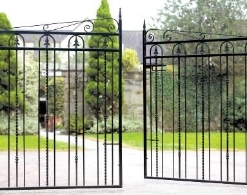
So imagine this… you're enjoying your morning cuppa when you spot your neighbour installing a gate directly onto your fence. Your blood pressure shoots up faster than house prices in London! And you immediately think - can they actually do that?
The Short Answer (Because Nobody Likes Suspense)
No, your neighbour can't just attach a gate to your fence without permission. It's your property, your rules. Simple as that.
But here's where it gets interesting—and slightly messy because property boundaries aren't always crystal clear. Sometimes that fence you think is yours might actually belong to your neighbour. Or worse, it could be a party fence—shared between both properties.
Most people assume the fence on the left side of their property belongs to them. That's not how it works. The only way to know for certain is by checking your property deeds or having a proper boundary survey done.
We actually had a customer from Manchester who was absolutely convinced his Victorian terrace fence was his. Turns out, it belonged to next door. Three months of heated arguments could've been avoided with a quick check of the Land Registry documents.
The Legal Bits (Don't Worry, we'll Keep It Simple)
Under the Party Wall Act 1996, any work affecting a boundary structure requires agreement from both parties. This includes attaching gates, drilling holes, or making any modifications.
Your neighbour needs your written consent before touching your fence. Without it, they're technically trespassing and could face legal action. Which let’s face it – is a last resort.
However, if it's a party fence—meaning it sits directly on the boundary line—then parties have rights to use it, but modifications still need mutual agreement.
What About Permitted Development Rights?
Here's something that catches people off guard as even if your neighbour has permitted development rights for their gate, those rights don't extend to using your property as support.
A good way to think of this is as follows; you can build an extension under permitted development, but you can't carte-blanche use your neighbour's wall to hold it up without permission. And let's be real, most fence disputes aren't solved by waving legal documents around. Who’s got the time? They're better sorted through conversation and compromise.
If your neighbour approaches you about attaching a gate, consider the bigger picture. Will it affect your fence's structural integrity? Does their gate open onto your property? Would they be willing to cover any maintenance costs?
We know of a situation where a compromise was indeed reached – which benefited both sides of the fence. One family in Devon agreed to let next door attach their gate in exchange for them maintaining that entire section of fencing. Win-win right!
Red Flags to Watch For
Be wary if your neighbour starts work without discussing it first, as that's never a good sign. It shows that there may be something they haven’t seen or done that could land them in a spot of bother. Also, watch out for any enhancements or modifications that could weaken your fence… and/or create access issues.
One customer told us once that their neighbour installed such a heavy wrought iron gate that it pulled their entire fence panel out of alignment. The repair costs were astronomical. This is something that can be easily avoided, just by talking it out.
And so… The Bottom Line
Your neighbour simply cannot attach a gate to your fence without your explicit permission. Even on party (mutual) fences, modifications require agreement from both sides.
If they've already done it without asking, you have legal grounds to demand its removal. But honestly? Try talking first. Most people are reasonable when you explain the situation properly.
Remember, good fences make good neighbours—but only when everyone respects the boundaries!
At Wrought Iron Gates Direct, we've helped thousands of customers navigate boundary issues and gate installations across the UK. Our team understands both the technical and legal aspects of fence-related disputes, ensuring your installation meets all requirements while maintaining neighbourly relations.



